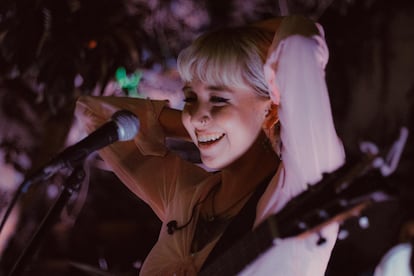In search of the new Mexican song
They are not the most famous or the most played on streaming services, but these tunes connect precisely with their generation. The key? Classic, honest and direct songs

In addition to the most radio-friendly trap and reggaeton, international pop and the boom of bellicose corridos tumbados, Mexico also has a plethora of young artists who are injecting new energy into music. They are turning to the Mexican song’s classic structure, while at the same time experimenting with styles, sounds and disciplines from elsewhere, creating music with a personality and diversity rarely seen before.
A few years ago, artists like Juan Cirerol, Ed Maverick, Carla Rivarola and Israel Ramirez began to revive the Mexican popular songbook with new references while also drawing on the rockers, troubadours, urban musicians, folk musicians, ranchera singers, gritantes [from Mariachi music] and bolero singers who came before them. Now, the current underground horizon is illuminated by sensibilities that speak precisely of their time and space. If in the metaphors of Zurdok, Jumbo, Santa Sabina or Julieta Venegas spoke intimately of common feelings, today groups like Hermanas, Tía Rosa and Perritos Genéricos perhaps approach the everyday figure more playfully, colorfully and closely.
In pop, electronic experimentation, trip-hop, romantic queer, neo-trova and countless other hybrids, the new Mexican song encompasses hundreds of artists from different disciplines: poets who intone, visual artists who sculpt sounds, and curious people with a musical spirit who strum their guitars in a carefree way to talk about their steps, their money troubles and generational anguish. They are lyricists and songwriters between 20 and 40 years of age, who perform and expose their most intimate universe in a bar, an ephemeral cultural forum, café or improvised place, creating a remarkable link with whoever has a few minutes available.
Beneath the thousands of reproductions by the current massive artists and record labels, a new generation of singer-songwriters is emerging in Mexico. They rely on the immediate forcefulness and frankness provided by the most classic songs, be it a bolero, a ranchera, a ballad, a corrido or simply a rola, as some still call it in the countryside.
While in the past the countercurrent to mainstream music also made use of effective musical formulas, with metaphors and well-intoned poetic quadrature, today’s new Mexican song appeals more to an image of precision, with frank verses and pragmatic enjambments with which to dialogue. In a way, they’re picking up the baton from the last wave of Mexican rock of the late 1990s and the first decade of the new century.
“I don’t know if it’s a very new thing, but the modern song has been cooking for about ten years or more (...). I think there is a lot of the singer-songwriter in Mexican culture, which was pushed aside in the last century, in an attempt of generational differentiation by the young people of the 1970s and 1980s, but in this century, and especially in this decade, it may no longer make much sense. Children now have aesthetic references to so many things, that everything they discover is valued for what it is, not so much for what it meant to the previous generation, but for the new meaning they give it at this moment”, says Raquel Miserachi, a journalist and radio broadcaster (Aire Libre, Ibero Radio, Resistencia Modulada).
Whereas rock and electronica were the main home of the most representative sound offerings from the usual places (Mexico City, Guadalajara and Monterrey), the musical imprint of the last two decades draws on each locality’s folk music, from the liveliness of its lyricism and timeless vitality rooted in the very Mexican ‘chorus-verse-chorus.’
From the naturalistic sweetness of Apache O’ Raspi (Torreón) to the polychromatic poetry of Geo Equihua (CDMX), the wild verses of Lázaro Cristóbal Comala (Durango) and the sensitively chosen lines of Alejandro Albarrán (Veracruz), to the oblique trap of artists like Cuauh (Michoacán) and even the cathartic darkness of Palacio Infantil (Oaxaca), from north to south, the modern Mexican song is a precise cultural barometer and a symptom of convulsive times in the margins of daily life.
The new Mexican song’s lyrics inhabit Mexico city’s most sordid and incongruous streets, climate change and impossible loves, but also of diverse friendships, adult fantasies and the eternal dream of, one day, living an untroubled life in the countryside without the need to validate oneself with an institution, a company or a yardstick based on conventional socioeconomic status.
Intuition and freedom
For Israel Ramírez (Belafonte Sensacional), the song’s classic format in Spanish has creative potential full of intuition and closeness, as it can build an important bridge of communication between people: “You can know if it says something to them or not, if they sing it or not, if they interpret it as I wrote it or if they change the words to it. It is something beautiful because, while trite, the song ceases to be one’s own and begins a pilgrimage of meanings and transformations. On the other hand, it is also a literary work. Let’s say that a book of poems has to be ‘authorized’ by a series of cultural institutions in order to be validated. In that sense, the song is free; it does not need validation, it is enough to sing it to be the air and syllable of other voices,” he points out.

Unlike past decades, when marginal and independent Mexican music made use of guitar rock and electronic music (either its abstract exploration or dance-oriented aspects), some believe that the current return to the classic song format is largely a response to the industry’s oversupply and media saturation, while others think it is more a response to the ease and historical immediacy that the song (with or without guitar) can provide as a tool or a creative exercise.
“I notice that, in some form, there has been a return to Latin American music, and to the folk music sound, to revive certain melodies and rhythms that were born in the colonial mix. It is a very beautiful time, where the music of artists like Violeta Parra, Simón Díaz, the llanero song and the Chilean cueca, things like that are being reinterpreted, sometimes with rock that in the end is also the result of a mixture between blues and gringo folk. It is a new song in a renovating sense, because it retakes, explores and investigates sounds,” says Alejandro Albarrán Polanco, a poet and singer from the capital who lives in Xalapa, Veracruz.
For singer, actress and trans outreach educator Luisa Almaguer, it is important to pay attention to the immediacy of the times to better understand this moment, since there is a kind of double reality, while saturation also provides enough elements to counteract or navigate in the opposite direction: “More than anything, I think song today can be interpreted in many ways and therefore you can identify yourself in other ways, even if that was not the writers’ intention, because of the way we consume things now, including the culture of memes and Tik Tok,” the author of “Wey” and “Básica” emphasizes.
Underneath the eternal structure of intro-chorus-chorus-verse-chorus, there is also the possibility of telling stories in multiple ways, of expressing emotions non-linearly, as well as exposing personal or collective problems, symbolically or without leaving room for interpretation. Since its beginnings, song has been a vehicle for information, memory and recording public and private life, but it is also often equal parts joy and anguish, even an instrument for changing the world.
“The hardest art is protest music, often inevitably so. Works always reflect the social context in which they are created, and I feel that music, and entertainment channels in general, have the most power to transform people. Also, people become a reflection of what they listen to and there is always a response to its positions; there is evolution and change,” reflects Idalee Ruíz, better known as Maltripeada.
For Torreonita musician Apache O’ Raspi, the power of change and transformation in the new Mexican song can be sensed, much more subtly, in its artists’ organization and self-management: “A song can be a seed for change, especially when it is an excuse to bring people together and encourage them to collaborate. I believe in singer-songwriters who are seeking to organize themselves with musicians to play live and also collaborate with other performing arts, gaining ground in the public sphere and leaving behind this false idea of individualized music to promote more of ‘the song’s activity,’ which is then taken on stage where it can resonate in its maximum splendor, and it brings people closer.”
Beyond the generational issue, Mexican youth songs land in a special way in something much more immediate, an identification with the listener. As singer-songwriter Víctor Rosas observes, “songs can have a lot of power, that’s why there are people who connect so much with some of them, because as with poetry there is polysemy and it can mean so much to someone, to the point of feeling identified, represented and understood through a song.”
With Tiny Richie, Vanessa Zamora, Pønce, Anthony Escandón, Valeria Jasso, Gustavo Acevedo, Dolor de Sombrero, Maricuir, Daniel Quien, Antiwa, Angela Bloem, Anan, Walter Esaú, Tutute and an ever growing, extensive and nurtured list of artists with their own stamp, the Mexican song carries on in full health.
Sign up for our weekly newsletter to get more English-language news coverage from EL PAÍS USA Edition
Tu suscripción se está usando en otro dispositivo
¿Quieres añadir otro usuario a tu suscripción?
Si continúas leyendo en este dispositivo, no se podrá leer en el otro.
FlechaTu suscripción se está usando en otro dispositivo y solo puedes acceder a EL PAÍS desde un dispositivo a la vez.
Si quieres compartir tu cuenta, cambia tu suscripción a la modalidad Premium, así podrás añadir otro usuario. Cada uno accederá con su propia cuenta de email, lo que os permitirá personalizar vuestra experiencia en EL PAÍS.
¿Tienes una suscripción de empresa? Accede aquí para contratar más cuentas.
En el caso de no saber quién está usando tu cuenta, te recomendamos cambiar tu contraseña aquí.
Si decides continuar compartiendo tu cuenta, este mensaje se mostrará en tu dispositivo y en el de la otra persona que está usando tu cuenta de forma indefinida, afectando a tu experiencia de lectura. Puedes consultar aquí los términos y condiciones de la suscripción digital.
More information
Archived In
Últimas noticias
Most viewed
- Alain Aspect, Nobel laureate in physics: ‘Einstein was so smart that he would have had to recognize quantum entanglement’
- Maps of the US attack on Venezuela: Targets, airspace and deployed fleet
- Oil, gold and rare earth elements: the backdrop to US political tension with Venezuela
- Key points of the military attack on Venezuela: Early morning bombings and a ‘captured’ president
- The US bombing of Venezuela, in pictures











































